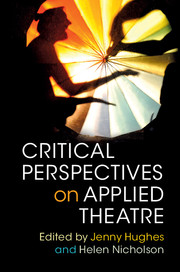Book contents
- Frontmatter
- Contents
- List of figures
- List of contributors
- 1 Applied theatre: ecology of practices
- PART I HISTORIES AND CULTURAL MEMORIES
- PART II PLACE, COMMUNITY AND ENVIRONMENT
- 6 Performing location: place and applied theatre
- 7 Peacebuilding performances in the aftermath of war: lessons from Bougainville
- 8 Applied theatre and climate change in Bangladesh: indigenous theatrics for neoliberal theatricks
- 9 Applied theatre and disaster capitalism: resisting and rebuilding in Christchurch
- PART III POETICS AND PARTICIPATION
- Notes
- Index
- References
6 - Performing location: place and applied theatre
from PART II - PLACE, COMMUNITY AND ENVIRONMENT
Published online by Cambridge University Press: 05 April 2016
- Frontmatter
- Contents
- List of figures
- List of contributors
- 1 Applied theatre: ecology of practices
- PART I HISTORIES AND CULTURAL MEMORIES
- PART II PLACE, COMMUNITY AND ENVIRONMENT
- 6 Performing location: place and applied theatre
- 7 Peacebuilding performances in the aftermath of war: lessons from Bougainville
- 8 Applied theatre and climate change in Bangladesh: indigenous theatrics for neoliberal theatricks
- 9 Applied theatre and disaster capitalism: resisting and rebuilding in Christchurch
- PART III POETICS AND PARTICIPATION
- Notes
- Index
- References
Summary
This chapter privileges and holds up for scrutiny the intimate relationship between applied theatre and place. Applied theatre researchers and practitioners engage with people in their contexts and locations, and people's relationship to their locus is immanent in our work. Our practices can trouble the meanings of place, destabilising suppositions of locality, dwelling, inhabitation, territory, indigeneity, community, residence, belonging, connection and ownership. Here, I present an argument about how applied work identifies, makes explicit, interrogates and shifts or alters relationships with place. Such practice can manifest itself in many different ways: places from the past, or that have been left behind, can be glimpsed through performance-related projects as part of a palimpsest of personal narrative; quotidian, dull and embedded places might be defamiliarised and re-envisioned; places of fear can be made familiar and more comfortable; performance practices can invoke or construct allegiance to ‘special’ places, perhaps even replacing long-lived rootedness with attachment to temporary places. These different outcomes from ‘performing place’ suggest that a simple rendering of place and its inhabitation is not possible. Place can be reconceived conceptually and practically to reference alienation and attachment, roots and routes, stasis and mobility and practices can reveal, expose, heal, enhance and alter people's response to their inhabitation and dwelling.
The relationship between place (and space) and applied theatre has been interpreted simply, perhaps too simply, in applied theatre scholarship. As has been noted, work happens in non-traditional venues, in places that are not associated with formal performance (Prentki and Preston 2009: 9). Some applied work might be performed in theatres, of course, and non-theatre sites themselves can be interpreted as performative (Thompson and Schechner 2004: 13), but there is broad agreement that most applied work takes place in community locations, educational settings or alternative sites. It is ‘ambulant and peripatetic’ as Nicola Shaughnessy suggests (2012: 98), making use of sites and places that are often local for the participants if not for the practitioners. An additional and also reasonably straightforward understanding of the relationship between applied theatre, place and space is the familiar concept of the ‘safe space’ to work in. Juliana Saxton and Monica Prendergast regard such a space as physically and emotionally safe (2011: 33–34) and Mary Ann Hunter considers space as facilitating risk-taking as well as providing protection (2008: 5). This is a relatively uncontested and embedded mantra of the field.
- Type
- Chapter
- Information
- Critical Perspectives on Applied Theatre , pp. 107 - 126Publisher: Cambridge University PressPrint publication year: 2016
References
- 14
- Cited by



